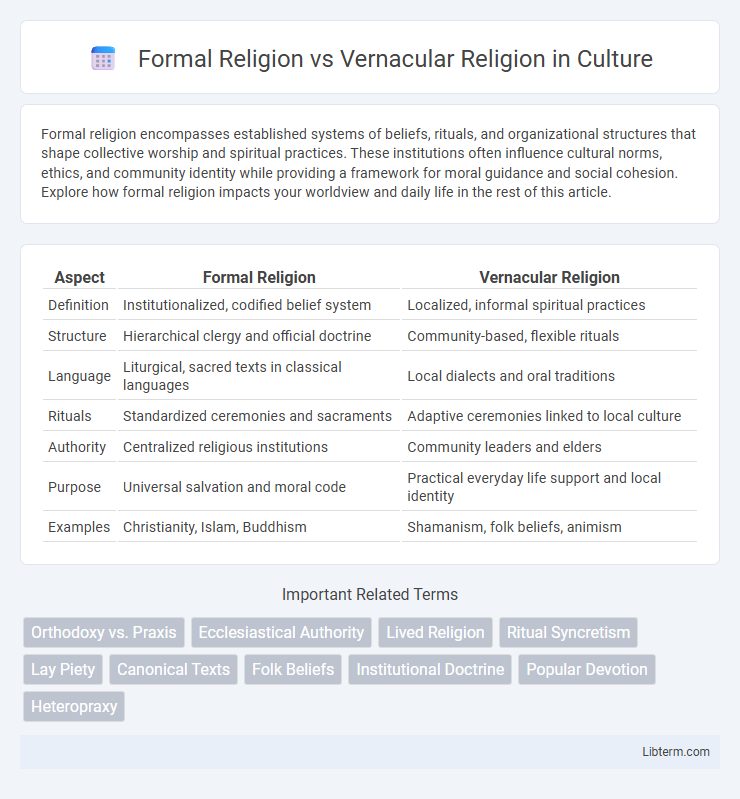Formal religion encompasses established systems of beliefs, rituals, and organizational structures that shape collective worship and spiritual practices. These institutions often influence cultural norms, ethics, and community identity while providing a framework for moral guidance and social cohesion. Explore how formal religion impacts your worldview and daily life in the rest of this article.
Table of Comparison
| Aspect | Formal Religion | Vernacular Religion |
|---|---|---|
| Definition | Institutionalized, codified belief system | Localized, informal spiritual practices |
| Structure | Hierarchical clergy and official doctrine | Community-based, flexible rituals |
| Language | Liturgical, sacred texts in classical languages | Local dialects and oral traditions |
| Rituals | Standardized ceremonies and sacraments | Adaptive ceremonies linked to local culture |
| Authority | Centralized religious institutions | Community leaders and elders |
| Purpose | Universal salvation and moral code | Practical everyday life support and local identity |
| Examples | Christianity, Islam, Buddhism | Shamanism, folk beliefs, animism |
Defining Formal Religion: Core Structures and Doctrines
Formal religion is characterized by established institutions, codified doctrines, and standardized rituals that define its core structure and belief system. It relies on hierarchical leadership, sacred texts, and official ceremonies to maintain uniformity and authority among adherents. These elements ensure consistency in worship practices and theological interpretations across diverse communities within the religion.
Vernacular Religion: Everyday Beliefs and Practices
Vernacular religion encompasses everyday beliefs and practices rooted in local culture, often transmitted orally and adapted to community needs. It contrasts formal religion by emphasizing personalized rituals, folk healing, and ancestral worship outside institutional doctrines. These practices reflect dynamic spiritual expressions that shape identity and social cohesion in daily life.
Institutional Authority vs. Individual Spirituality
Formal religion relies heavily on institutional authority, with structured doctrines, rituals, and clergy guiding believers through established hierarchies and canonical texts. Vernacular religion emphasizes individual spirituality, personal experiences, and localized practices often outside official religious frameworks, allowing for a more flexible and adaptive faith expression. This contrast highlights the tension between centralized control and personalized belief systems in shaping religious identity.
The Role of Rituals in Formal and Vernacular Religion
Rituals in formal religion are structured, codified ceremonies often performed by clergy within designated sacred spaces, reinforcing institutional beliefs and community identity. In vernacular religion, rituals are more fluid, personalized practices rooted in local customs and everyday life, reflecting individual and communal expressions of faith. These contrasting ritual forms highlight how formal religion emphasizes uniformity and doctrinal authority, while vernacular religion fosters adaptability and cultural integration.
Adaptation and Syncretism in Vernacular Practices
Vernacular religion exhibits significant adaptation and syncretism by blending local customs, indigenous beliefs, and formal religious doctrines to create personalized spiritual practices that resonate with community identities. This dynamic integration allows vernacular traditions to evolve fluidly, incorporating rituals, symbols, and deities from diverse sources while maintaining practical relevance and social cohesion. As a result, vernacular religion often reflects a hybridized spirituality distinct from the more rigid and codified structures of formal religion.
Religious Texts: Canonical vs. Local Interpretations
Formal religion relies on canonical religious texts that undergo rigorous validation processes, ensuring consistency and uniformity across global adherents, such as the Bible in Christianity or the Quran in Islam. Vernacular religion emphasizes local interpretations and oral traditions that adapt sacred teachings to cultural contexts, often blending canonical doctrines with indigenous beliefs and practices. This dynamic interaction between canonical texts and vernacular interpretations shapes diverse religious expressions and community identities within broader faith traditions.
Social Functions of Formal and Vernacular Religion
Formal religion establishes structured institutions, codified doctrines, and organized rituals that promote social cohesion, collective identity, and moral order within large communities. Vernacular religion reflects localized practices and personalized beliefs, fostering social bonds through shared everyday traditions and adaptive spiritual expressions that address immediate communal needs. Both forms contribute to social stability by reinforcing norms, providing meaning, and facilitating interpersonal connections across different social strata.
Conflict and Harmony: Coexistence of the Two Forms
Formal religion, characterized by institutionalized doctrines and hierarchical structures, often encounters conflict with vernacular religion, which is rooted in localized, folk practices and individual expressions of faith. Despite tensions, both forms frequently coexist, influencing each other through syncretism and adaptive rituals that blend official teachings with popular beliefs. This dynamic interplay fosters a complex religious landscape where formal doctrines gain cultural relevance while vernacular traditions attain broader recognition.
Evolution of Belief Systems Across Cultures
Formal religion typically involves organized doctrines, codified rituals, and hierarchical structures that maintain standardized practices and beliefs across generations. Vernacular religion evolves organically within local communities, blending traditional customs, oral narratives, and indigenous spirituality, reflecting the dynamic adaptation of belief systems to cultural and environmental contexts. The evolution of belief systems across cultures demonstrates a continuous interplay between institutional religious authority and grassroots spiritual expressions, shaping diverse religious landscapes worldwide.
The Future of Religion: Blurring Boundaries and Emerging Trends
The future of religion shows increasing convergence between formal religion and vernacular religion as digital media and globalization amplify personal spiritual expressions alongside institutional doctrines. Emerging trends indicate a rise in hybrid religious practices where traditional rituals merge with localized beliefs, creating fluid spiritual identities beyond rigid organizational boundaries. This blurring of religious categories fosters inclusive communities that adapt ancient teachings to contemporary societal needs while preserving diverse cultural heritages.
Formal Religion Infographic

 libterm.com
libterm.com